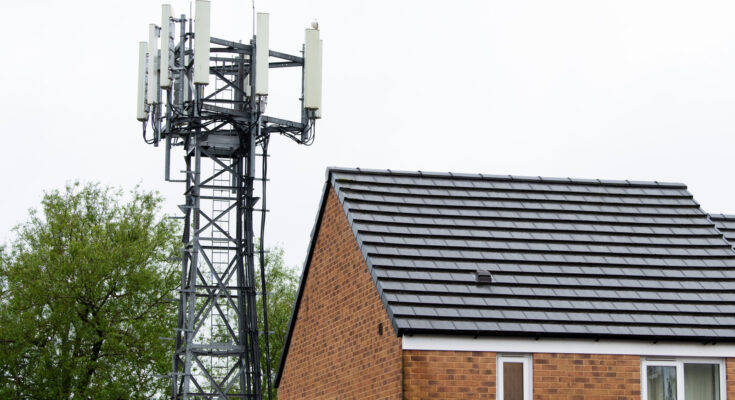What Is EMF Paint, And Do You Need It? Here’s What The Science Says
We may receive a commission on purchases made from links.
Although the idea of shielding yourself from electromagnetic fields (EMF) sounds like something out of a science fiction movie, some consumers are seeking simple ways to limit their exposure to the potential health impacts from radiation coming off their smartphones, wireless networks, and nearby cellular towers. As high-tech kitchen appliance trends emerge and households become more reliant on the Internet of Things, most of us are exposed to more electromagnetic radiation than ever before. In a number of recent studies, exposure to EMFs has been suggested to cause everything from mental health disturbances to increased risk of tumors. It’s nearly impossible to eliminate EMF exposure, but many people are looking for ways to protect themselves in their homes. According to Ryan Blaser, b.sc., E.E., EMRS, BBEC, HAAV, Founder of Test My Home, EMF paint is a shielding product that creates a barrier to radiofrequency (RF) radiation, which is ideal for sensitive individuals who want to reduce their exposure.
“EMF paint is a specialized shielding product that contains conductive materials, typically carbon-based, which help block or reduce exposure to electromagnetic fields (EMFs), especially from sources like cell towers, smart meters, and Wi-Fi routers,” Blaser told House Digest during an exclusive interview. The electromagnetic radiation specialist went on to discuss the science behind EMF paint. “These paints are designed to have high surface conductivity, which reflects or absorbs RF energy,” he said, adding that the paints are 3rd party tested to measure their effectiveness in decibels. “Most paints [offer] 99% or more reduction at certain frequencies when properly applied and grounded,” Blaser explained.
The pros and cons of using EMF paint
There are a lot of mistakes everyone makes when choosing a paint color for their home, but when you’re considering a specialty coating like EMF paint, you need to think beyond the perfect hue and sheen. In an exclusive interview with House Digest, Blaser said there are both pros and cons to using products like EMF Protection’s Shielding Solutions YSHIELD. Along with offering a “high reduction of RF exposure, especially useful for better sleep and recovery,” Blaser called EMF paint a “long-term solution when applied correctly and combined with proper grounding.” He also explained that it is compatible with other shielding methods like ZTTXL’s Faraday Military Grade Conductive Material.
On the other hand, EMF paint also has some downsides. Blaser said it is “more costly and involved than plug-in or portable shielding solutions.” He added that it also has to be grounded, which means it’s one of those electrical projects you shouldn’t attempt unless you’re a professional. One of the biggest downsides of all is the way it will impact your digital devices. Blaser explained that using EMF paint “can impact cell signal and Wi-Fi strength inside the home, which may require rerouting devices or hardwiring.” We also learned that, although some EMF paints can be painted over with traditional paints in the color of your choosing without losing their effectiveness, most are available only in black or grey colors and cost more than the average gallon at your local big box store. This can make it harder and more expensive to achieve the aesthetic you’re after.
EMF testing helps determine exposure but researchers aren’t convinced it’s a problem
EMF paint is not right for everyone. You’ll need to consider your situation carefully before making the investment. “I do recommend it in the right context,” Blaser told House Digest during his exclusive interview. “EMF paint can be incredibly effective for reducing chronic RF exposure, especially for sensitive individuals or families near strong external sources like cell towers,” he said. “But it’s not a one-size-fits-all solution.”
According to WebMD, self-reporting indicates that electromagnetic hypersensitivity in the United States only impacts around 3.2% of the population, although some researchers have found higher rates during their studies. There are no set symptoms or medical guidelines, which means it can be hard to definitively attribute that insomnia or those persistent headaches to electromagnetic or radiofrequency exposure. If you’re concerned and trying to decide if EMF paint is right for your home, Blaser suggests reaching out to a professional. “I always recommend starting with testing — either via an in-person or remote EMF assessment to identify actual exposure sources,” he said. Testing looks for four different types of electromagnetic fields, as well as any sources of dirty energy in your home.
The World Health Organization acknowledges the need for continued research investigating the links between EMF exposure and cancer. However, it holds that “current evidence does not confirm the existence of any health consequences from exposure to low level electromagnetic fields.” EMF certifications, like those held by Blaser, are offered through formal training by private institutes. They are not regulated by federal or state licensure boards.



